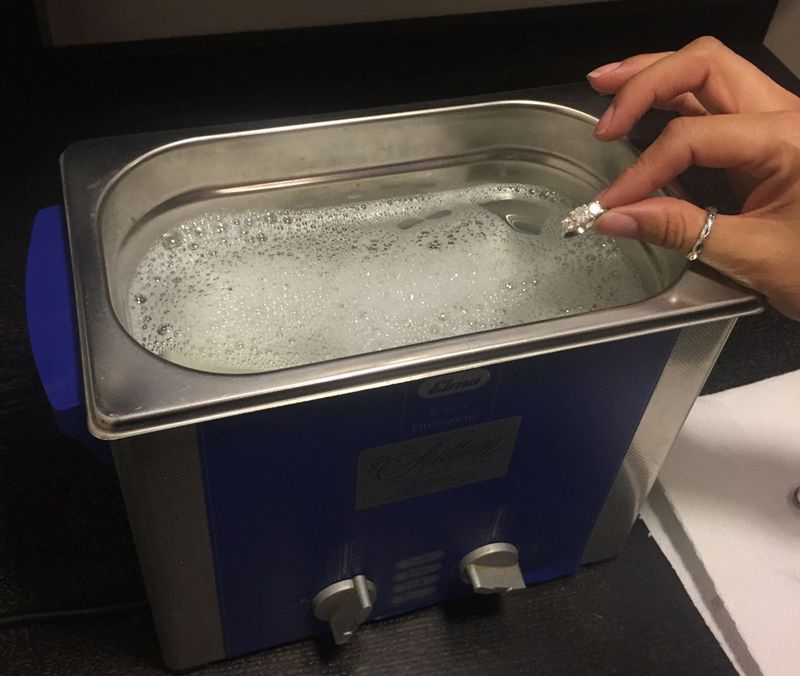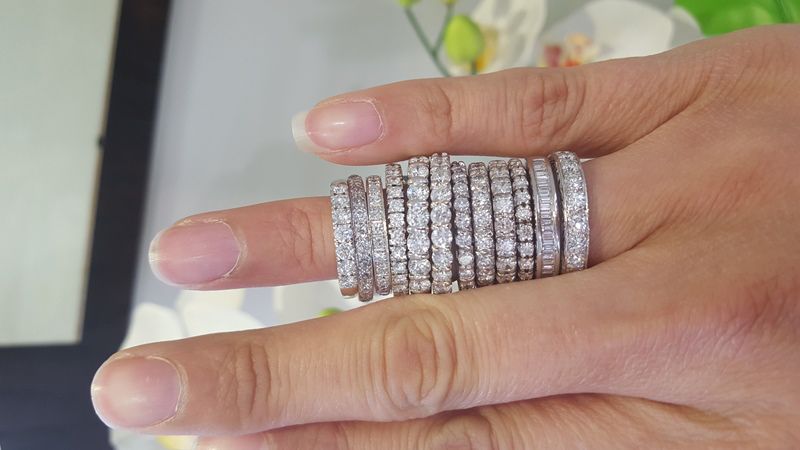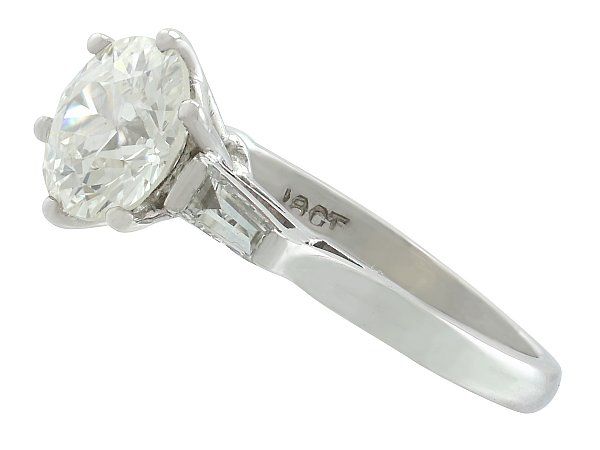White gold is a stunning, sleek and shiny alternative to other metals such as yellow gold and platinum. White gold jewellery was first made popular during the decadent Art Deco era in the 1920s. The elegant metal was thought to perfectly enhance diamond jewellery and it added to the clean cut pristine fashion styles which dominated this era.
Still a fashionable choice today, white gold is often chosen for engagement rings; especially for a bride with a modern taste. As its bright white look is one of its most appealing features, white gold engagement rings must be looked after carefully in order to keep it looking flawless!
This metal does have tendency to tarnish, therefore its necessary to get your white gold jewellery regularly re-plated in rhodium. As this re-plating process is a bit of a mystery to many, I will give you a brief insight into the process of rhodium plating and why it is so important…
Why Does It Need Rhodium Plating?
White gold is naturally a very soft metal. Thus, when used to make jewellery, it is alloyed with at least one other white metal. Metals used include nickel, magnesium or palladium. Because of this, the tones in the colour of the metal can vary slightly. It is all dependent on what the gold has been alloyed with. Another result of the alloying process is a tendency to grow dull/ stained/ brown over time.
There are other factors to consider however, when it comes to the discolouration of white gold jewellery. Rings (especially engagement/wedding rings), will need replating more frequently. Other pieces of jewellery (say, earrings for example) demand far less attention. This is because rings are far more likely to face wear and tear; coming into contact with harder or evasive substances more often.
How Does the Plating Process Work?
This is the part where we get into the nitty gritty science of jewellery. Remember, it is definitely not a DIY fix: if you feel like it’s time to get re-plating, talk to your jeweller and they will arrange this for you!
For our customers here at AC Silver, we offer yearly rhodium plating as a complimentary service if you have purchased the item from us.

For any of you that are intrigued by the scientific process that your ring undergoes when we take it to get re-plated for you, here’s a brief account:
1. Your jewellery will be expertly cleaned (polished, then put in the ultrasonic machine, rinsed in distilled water and then steam cleaned). It is essential that white gold is sparkling clean before it gets re-plated to ensure the best results!
2. Three solutions are prepared in beakers:
- Distilled water with two teaspoons of ‘electro clean powder’ and a stainless steel anode
- Distilled water with ‘activator powder’
- Distilled water with rhodium and a platinized titanium anode
- You will also need an extra beaker of distilled water for rinsing
3. When all of the beakers are prepared, the technician will turn on the rectifier machine and turn it up to 6 volts. The ‘electro clean’ solution and the rhodium solution will both be heated to 100 Degrees.
4. The positive lead of the rectifier machine will be placed on the stainless steel anode. The negative lead will be attached to a hooked wire- this is what the ring/piece of jewellery will be hooked on to.
5. Next, put the item (let’s say ‘ring’, for ease) into the ‘electro clean’ beaker and agitate it for roughly two minutes. Remove and rinse in distilled water.
6. Put the ring in the activator solution for 30 seconds (this beaker is not heated remember). Then rinse again.
7. While doing this, readjust the rectifier machine to 3 volts and attach the positive lead to the platinized titanium solution.
8. Lower the ring into the platinized titanium solution for 30 seconds and TA DA! Your ring is officially rhodium plated.
How Much Does Replating White Gold Cost?
Now, obviously this can vary from piece to piece, but most places in the UK will offer a replating at between £20 – £30. This can vary from jeweller to jeweller, however. If you bring in something especially tarnished or even damaged, it is likely to need more rigorous work, which could bring the price up. Equally, very large pieces of jewellery may cost more to replate than more delicate items.

We will always recommend going to a professional jeweller, however, rather than a retail store such as our own. It is best to get your valuables seen to by the person with the necessary expertise. As we’ve said, this is most definitely not a DIY project!
How Often Does my Jewellery Need Replating?
The answer we usually give to this question is roughly once a year. If your white jewellery is an engagement ring that you wear every day, getting it replated once a year is a good was to ensure its ongoing strength and vibrant white colour.
If your jewellery piece is something you don’t wear as often, such as earrings or perhaps a brooch, then it is likely that you won’t need to replate it so often. Ultimately, the best judge of if your jewellery needs replating is you. Keep an eye out for any discolouration or potential weakness in your jewellery, and if you notice a change take it to a jeweller as soon as possible, and avoid wearing it until it can be seen to by a professional.
Things that can affect how often your white jewellery needs replating include how often you wear the piece as well as what type of wear and tear it’s likely to face. If you wear a pendant most days and you’re also applying moisturisers and perfumes, that metal is more likely to tarnish faster than the metal of the bracelet you only wear on special occasions, for example.
Finally, as is the case with choosing of jewellery in the first place- it is a very personal thing. Your very skin could cause a piece to discolour more quickly due to a high PH balance. Even certain medications can seep through the skin and cause changes to the metal. This is why we say- there is no solid rule. Trust your instincts; if you feel like your gorgeous white gold ring is due a little care and attention, then it probably is!





